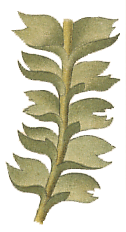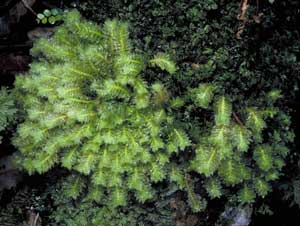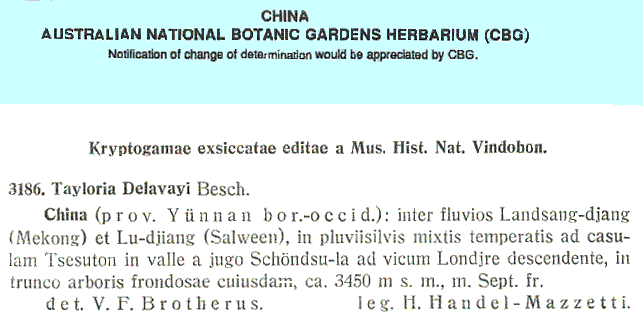
Bryogeography
Old literature and new ideas
The latter half of the 1800s and the early 1900s saw a great expansion in the botanical exploration of the non-European world but, even late into this period, there were fairly few bryologists outside Europe. In that period the European presence in other continents expanded greatly, through exploration, colonization, missionary work and trade. It is therefore no surprise to learn that over that time numerous non-European bryophyte collections made their way to European institutions. This period therefore saw the naming of numerous non-European specimens, mostly by Europeans who did not set foot outside Europe, and a significant amount of this work must be treated with scepticism. One of the reasons for this is that it was a common assumption amongst some bryologists that almost any bryophyte from a newly explored part of the world would be a new species. As a consequence numerous new species were created on very flimsy evidence. To use such work uncritically as support for some bryogeographical reasoning would clearly be very foolish.
The American liverwort specialist RM Schuster has written critically of "...workers like Colenso, Stephani, Kindberg et al., who described supposedly new species at an appalling rate and often in the wrong genus, family, or even order...". In Schuster's view the German bryologist Franz Stephani (1842-1927) was a conscientious worker in his early days but became overwhelmed by the great amount of exotic material that was sent to him. Stephani described over 3,000 new liverwort species "...usually with formalized and often meaningless..." descriptions. Between 1888 and 1910 the Swedish bryologist Nils Conrad Kindberg (1832-1910) published over 50 papers which concerned the mosses of North America. He described a number of new genera as well as numerous new species and subspecies. While most of Kindberg's new genera are still accepted, at the level of species and below "...Kindberg's work was a major disaster because it created far more problems than it solved...", according to the two American bryologists WC Steere and HA Crum. The Australian bryologists GAM Scott and IG Stone noted that the German bryologist Carl Müller (1818-1899) caused similar problems for the study of Australian mosses because he "...described so many ill-founded species that Australian bryology has been crippled by the burden..."![]() .
.
William Colenso (1811-1899) was born in Cornwall and arrived in New Zealand as a missionary-printer in 1834. He was interested in natural history and wrote widely about New Zealand's flora and fauna. Amongst other bryological contributions he described 32 new species in the leafy liverwort genus Schistochila between the years 1886 and 1889. A relatively recent study of the Australasian species in this genus concluded that 31 of Colenso's 32 "new" species were not new at all. The specimens on which Colenso had based those new species really belonged to species that had been previously defined. Perhaps Colenso was unfamiliar with the earlier work, perhaps the earlier work was unclear or perhaps Colenso failed to observe carefully enough. The accompanying photo shows Schistochila balfouriana, a description of which had been published, in England, in 1844 but based on material sent from New Zealand. Ten of Colenso's 32 "new" species are in fact just forms of Schistochila balfouriana. This liverwort has a wide distribution in New Zealand, is abundant and, to quote the authors of the following reference button, shows a "...distressingly broad range of variations...". At least a part of Colenso's problem was the failure to recognize the variation of which the species was capable, thereby leading him to create new species when all he was seeing was the natural variation in the one species![]() .
.
Many of Colenso's Schistochila specimens are still stored in various herbaria in New Zealand or elsewhere. This has made it possible to re-examine the bulk of the specimens on which Colenso based his 32 new species and clearly prove that those new species are unwarranted. Mind you, re-examining Colenso's original specimens took one of the authors of the preceding reference several hundred hours of work. The study had to be thorough in order to leave no uncertainty as to the status of the Colenso species. That amount of effort may not be needed for the examination of every questionable species but think back to just Stephani and his 3000 species. Clearly it would take a lot of work to re-check old species, and that assumes that the original specimens are still available for re-examination. When it comes to Müller's new species that sort of re-examination is largely impossible since the specimens he used are believed to have been destroyed during the bombing of Berlin in World War 2. For some the necessary re-examination has been possible because parts of the collections studied by Müller were lodged in other herbaria. Without access to the collections that were studied by the bryologists of the period we're talking about, it can be difficult or impossible to determine what the species in question actually are. It becomes necessary to rely on published descriptions that may be too brief or vague and which frequently lack accompanying illustrations. In such circumstances we are left unsure as to what species were found where and you can understand why many questionable species are still recorded in the literature.
So far we've looked at the problems created by unwarranted definitions of new species, It has also happened that collections from exotic areas were identified as belonging to species already known from Europe when they have in fact turned out to really be new species. Reliance on such conclusions would obviously lead to the erroneous conclusion that a particular species was far more widespread than is in fact the case.
Changing views
Over time, as old mistakes are fixed or as new evidence emerges, ideas about bryogeography may change. Sometimes new knowledge solves a problem, but in other cases it simply changes the nature of the problem. The rest of this page is devoted to several examples,
Tayloria rudolphiana has been mentioned in the introductory BRYOGEOGRAPHY page. To remind you of the essential point for the moment, the species is found in only two widely separated areas. One is in the south-west of China and the other is in central Europe. This species had been described in the 1840s, based on material collected in Europe. Another species, Tayloria delavayi, had been described in the 1890s, based on material collected in China by the French Jesuit missionary Père Jean-Marie Delavay (1834-1895) and named in his honour. A study published in 1992 concluded that they were in fact the same species. The name rudolphiana had been published before the name delavayi and therefore had priority, so the name Tayloria rudolphiana is the one now used for this species with the puzzling Europe/China distribution. Initially there had appeared to be two separate species, seemingly one endemic to Europe and the other to China. The challenge then would have been how to explain the occurrences of two such highly localized species. There is still a bryogeographical puzzle here, but now quite a different one![]() .
.
|
The species Tayloria maidenii was described in a paper (written in Latin) published by the Finnish bryologist Viktor Ferdinand Brotherus in 1916.The description was based on a specimen collected from Mt Kosciusko in New South Wales. In a brief comment after the description of the species Brotherus included the words species distinctissima, "a most distinctive species", but the Mt Kosciusko collection remained the only specimen of the species ever to be found. The authors of a paper published in 2003 noted that careful examination of the collection, using methods no different to those available to Brotherus, showed it to belong to the species Entosthodon laxus. The description of this species had originally been published in 1856 in a well-known and widely-read English botanical journal. Entosthodon laxus is widespread in the Southern Hemisphere, being known from south-eastern Australia, both islands of New Zealand, several sub-Antarctic islands and South America. Someone who had accepted Brotherus' species uncritically could easily have developed some fanciful scenarios regarding the history of Tayloria maidenii. Perhaps it was an old species, on the way to extinction, the highest peak in Australia being its last refuge. Or perhaps it was a species that had evolved recently, in isolation from other Tayloria species. However, Tayloria maidenii has now disappeared, along with any puzzles as to its relationship to other species in that genus.
There has been one other consequence of the study published in 2003. While there are numerous collections Entosthodon laxus from Tasmania, the collection from Mt Kosciusko has become only the third known collection of the species from mainland Australia. Of the other two collections, one was collected near Thredbo in 1975 and the other was collected by Ferdinand von Mueller in the Victorian Alps in 1855![]() .
.
The leafy liverwort Lophozia herzogiana was thought to have been introduced from New Zealand to Great Britain. That might still be true, but the story has become more complicated as more evidence has come to light and the LOPHOZIA HERZOGIANA CASE STUDY gives the details.
![An Australian Government Initiative [logo]](/images/austgovt_brown_90px.gif)



